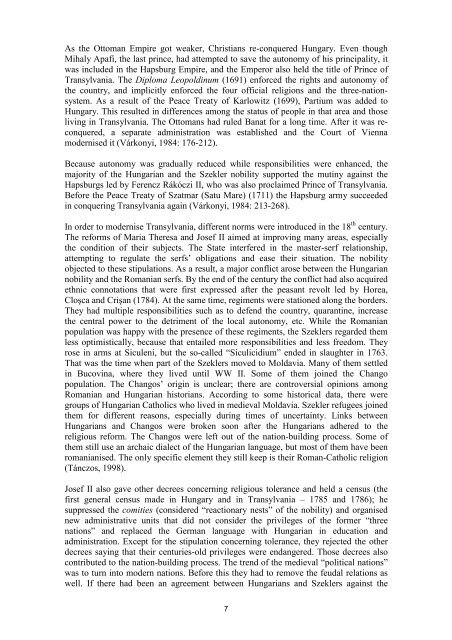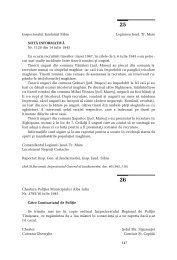Southeast Europe
Southeast Europe
Southeast Europe
You also want an ePaper? Increase the reach of your titles
YUMPU automatically turns print PDFs into web optimized ePapers that Google loves.
As the Ottoman Empire got weaker, Christians re-conquered Hungary. Even though<br />
Mihaly Apafi, the last prince, had attempted to save the autonomy of his principality, it<br />
was included in the Hapsburg Empire, and the Emperor also held the title of Prince of<br />
Transylvania. The Diploma Leopoldinum (1691) enforced the rights and autonomy of<br />
the country, and implicitly enforced the four official religions and the three-nationsystem.<br />
As a result of the Peace Treaty of Karlowitz (1699), Partium was added to<br />
Hungary. This resulted in differences among the status of people in that area and those<br />
living in Transylvania. The Ottomans had ruled Banat for a long time. After it was reconquered,<br />
a separate administration was established and the Court of Vienna<br />
modernised it (Várkonyi, 1984: 176-212).<br />
Because autonomy was gradually reduced while responsibilities were enhanced, the<br />
majority of the Hungarian and the Szekler nobility supported the mutiny against the<br />
Hapsburgs led by Ferencz Rákóczi II, who was also proclaimed Prince of Transylvania.<br />
Before the Peace Treaty of Szatmar (Satu Mare) (1711) the Hapsburg army succeeded<br />
in conquering Transylvania again (Várkonyi, 1984: 213-268).<br />
In order to modernise Transylvania, different norms were introduced in the 18 th century.<br />
The reforms of Maria Theresa and Josef II aimed at improving many areas, especially<br />
the condition of their subjects. The State interfered in the master-serf relationship,<br />
attempting to regulate the serfs’ obligations and ease their situation. The nobility<br />
objected to these stipulations. As a result, a major conflict arose between the Hungarian<br />
nobility and the Romanian serfs. By the end of the century the conflict had also acquired<br />
ethnic connotations that were first expressed after the peasant revolt led by Horea,<br />
Cloşca and Crişan (1784). At the same time, regiments were stationed along the borders.<br />
They had multiple responsibilities such as to defend the country, quarantine, increase<br />
the central power to the detriment of the local autonomy, etc. While the Romanian<br />
population was happy with the presence of these regiments, the Szeklers regarded them<br />
less optimistically, because that entailed more responsibilities and less freedom. They<br />
rose in arms at Siculeni, but the so-called “Siculicidium” ended in slaughter in 1763.<br />
That was the time when part of the Szeklers moved to Moldavia. Many of them settled<br />
in Bucovina, where they lived until WW II. Some of them joined the Chango<br />
population. The Changos’ origin is unclear; there are controversial opinions among<br />
Romanian and Hungarian historians. According to some historical data, there were<br />
groups of Hungarian Catholics who lived in medieval Moldavia. Szekler refugees joined<br />
them for different reasons, especially during times of uncertainty. Links between<br />
Hungarians and Changos were broken soon after the Hungarians adhered to the<br />
religious reform. The Changos were left out of the nation-building process. Some of<br />
them still use an archaic dialect of the Hungarian language, but most of them have been<br />
romanianised. The only specific element they still keep is their Roman-Catholic religion<br />
(Tánczos, 1998).<br />
Josef II also gave other decrees concerning religious tolerance and held a census (the<br />
first general census made in Hungary and in Transylvania – 1785 and 1786); he<br />
suppressed the comities (considered “reactionary nests” of the nobility) and organised<br />
new administrative units that did not consider the privileges of the former “three<br />
nations” and replaced the German language with Hungarian in education and<br />
administration. Except for the stipulation concerning tolerance, they rejected the other<br />
decrees saying that their centuries-old privileges were endangered. Those decrees also<br />
contributed to the nation-building process. The trend of the medieval “political nations”<br />
was to turn into modern nations. Before this they had to remove the feudal relations as<br />
well. If there had been an agreement between Hungarians and Szeklers against the<br />
7









